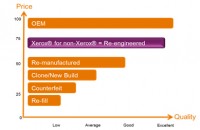In a blog, the OEM has failed to distinguish between clones, remanufactured and refilled cartridges, and claims all can bring “severe legal, health and environmental implications”.
The blog, on Xerox’ Channel Partner website, was written by Julian Patel, and is called When is a clone not a clone? The print supplies aftermarket unravelled. The blog tries to explain why original and Xerox re-engineered cartridges are preferable to third-party consumables, and a chart in the article (pictured right) seems also to suggest that clone or new-build cartridges are better quality than refilled cartridges, while remanufactured cartridges are simply “good” quality.
Patel adds that OEM cartridges are in top position “naturally”, as they are “the highest quality option specifically engineered to match the printers they were designed for”. Second are re-engineered cartridges from Xerox, a “great alternative” to OEM originals that “deliver outstanding quality for a lower customer price point”. Remanufactured cartridges receive no further discussion, but are instead grouped with “cloned, counterfeit or refilled” cartridges.
Patel recommends channel partners ask “where and how were these cartridges built”, despite remanufactured and refilled cartridges using OEM originals, as well as asking partners to look at whether “health and safety procedures [were] followed to ensure the well-being of the people who made them”. Other questions include whether there are “any toxicity issues with the toner or component parts that could cause potential health issues”.
He outlines “six reasons not to dabble in the clone zone”, including that “bargain brand cartridges often infringe OEM patents […] if you sell them you are breaking the law and can face prosecution”. Even if a patent “is not violated”, the “clone may infringe the OEM’s intellectual property which is also illegal and a criminal offence”. The four types of cartridges “can damage printers”, he adds, meaning “you may be liable for repairs, replacement of even loss of productivity or business”, while some “clones” contain what he claims are “environmentally hazardous toxic chemicals which could damage the user’s health. Morally and commercially this is a risk not worth taking”.
He contends that “it can be genuinely difficult to discriminate between a quality OEM product and a clone”, and “dabbling in the lower end of the supplies aftermarket is to be avoided”. This is because, in his view, there are “severe legal, health and environmental implications […] at best it’s a false economy, and, at worst, it is commercial suicide”.

